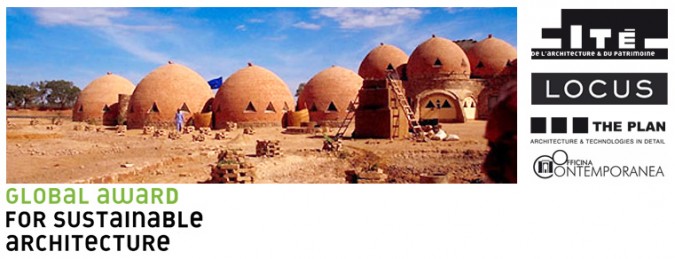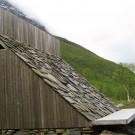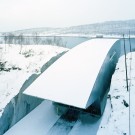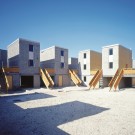Photography show – Global Award for Sustainable Architecture

The opening of the photo exhibition “Global Award for Sustainable Architecture” will take place at 18:00 on Wednesday May 4th, in the showroom of Officina Contemporanea, in Via Mutilati 8/a, Verona. It is organized by the architecture magazine The Plan, member of GBC Italy, with the collaboration of Officina Contemporanea and Atelieritaliano as well as the patronage of the Ordine degli Architetti di Verona, AGAV and GIARCH. The show is promoted by Cité de l’Architecture & du Patrimoine of Paris.
The exhibit will be open weekdays from 10:00 till 18:00 through Friday May 20th. Entrance is free.
EXPO GA: INTRODUCTION
The environmental and energy crisis strikes everywhere at the same time. Up till now a simultaneous fracturing of this dimension has never been verified.
In the twentieth century, industrial development aligned itself with the ‘myth of progress’, which diffused the same model of life and of city, in relationship to every society and it’s history. Today the myths of ‘sustainable development’ begin at the same time, but no longer use the same energy or follow the same development.
The fulcrum with priority is found in the city and in architecture. In terms of the real cost of expended energy and resources, cities and architecture are the workshops for a sustainable future and for the profound transformation that sustainability requires. From Chile to Finland, From the United States to China, an avant-garde architecture follows a new perspective: constructing our global civilization on a base of new relationships between society and resources.
The west is the seat of numerous creative centers: energy and materials are the focal points of an industrial revolution in which architects are the defenders. A new collective story is birthing: architecture concretizes it, giving it form and meaning. In the southern hemisphere, the crisis is rewriting the equations of development: technology and society, development and progress city and equity…The emerging situation frequently leads to more radical innovations than in the west, foretelling of new relationships between north and south. Architecture is delineating a new scenario at a global level. The exchanges between the protagonists of the architecture scene are intense, directed towards the sharing of ethical objectives and limits. The globalized planning that marks the last years of the twentieth century gives way to the universality of an architecture that reflects the search for a new equilibrium in the most profound characteristics of each territory. Every project becomes a fragment of the world and gives order to the world.
The Global Award for Sustainable Architecture was instituted to promote International debate of architecture. Five architects are awarded each year for sharing the ethic of sustainable development and for having formalized innovative and ecological plans whether in the west or in emerging countries, in the cities of the developed world or in favor of the most vulnerable of the planet’s populations. The scope of the Global Award for Sustainable Architecture is the construction of a community of these greatly talented architects, the publication of their methodologies and the stimulation of experiential exchange between north and south. Since 2007 fifteen architects have been given awards. The intent of this show is to make known this new avant garde.
Stefan Behnisch – Stoccarda, Germany – Prize 2007
Stefan Behnisch is a pioneer of architecture for a sustainable climate and environment. He plans buildings as great protected and seductive ecosystems that propose a new way of living. “Optimize spaces for greater comfort”.
Balkrishna Doshi – Ahmedabad, India – Prize 2007
Inhabiting: a process, not a product.
Doshi was not yet thirty when he worked alongside Le Corbusier on the new capital at Chandigarh, that became an emblem. The diffusion of the modern movement was received with favor by western critics. The critics identified the paladins of each continent. Doshi was included on this list.
In 1978 he founded the Vastu Shilpa Foundation, dedicated to research the social and developmental aspects of building. With regard to those themes, Doshi has continued his self-interrogation, principally occupying himself with construction for the Indian population rather than construction for ‘India’.
Françoise-Hélène Jourda – Paris, France – Prize 2007
An ecologic European culture
In 1980 Françoise-Hélène Jourda won the French competition “A habitat with economic energy”. With this she became the leader of ecologic change in France and interfaced with the Nordic and German thoughts regarding sustainable architecture. “Architects must stop building monuments”.
Hermann Kaufmann – Schwarzach, Vorarlberg, Austria – Prize 2007
Wood, creative materials
The career of Hermann Kaufman is inseparable from the history of Vorarlberg, the region of Austria that for over thirty years has been a laboratory for sustainable architecture. “We are at the very beginning of a great taking of social and political conscience”.
Wang Shu and Lu Wenyu – Amateur Architecture Studio – Hangzhou, China – Prize 2007
History meets creativity
China has initiated the construction of numerous ”eco-cities” and green zones. The methodology, followed so far, has as its point of reference the “tabula rasa”. On the other hand, in the meridian city of Hangzhou, Wang Shu proposes a different perspective. “The modern in China can be refined by means of its culture.”
Fabrizio Caròla – Naples, Italy – Prize 2008
Europe-Africa, a cultural exchange between “equals”
Fabrizio Caròla has dedicated his life to inventing techniques and a specific art of construction, which match up well with African resources. In 1973, while living in Mali as an expert on development projects, he noted that most people sent to Africa to eliminate the technological difference had cultural baggage and limited humanism. The lack of preparation of the personnel led them to bring into Africa, without any editing, the most absurd products of our civilization. The quality of these products, brought into places still unprepared to receive them, makes the situation worse. “The cupola of bricks had never crossed the Sahara.”
Elemental/Alejandro Aravena – Santiago, Chile – Prize 2008
The most important sustainable resource is the city.
Alejandro Aravena planned Elemental in 2000 to replace the favelas that were invading urban areas crucial for sustainable residential building. Elemental proposed to construct with meager financial resources profiting from the use of economic materials (cement and bricks) and with self managed building. “Màs con lo mismo”
Rural Studio/Andrew Freear, director – Auburn University, Alabama, USA – Prize 2008
Renew houses to renew society
Created in 1992 by Samuel Mockbee and D.K. Ruth, Rural Studio, situated in Hale County, has coherently put into practice an ecological vision with southern origins. The agricultural theorist, Wendel Berry, has affirmed that after the economic cyclone of the twentieth century, American society needs to reconstruct itself starting with the fundamentals: community, ethics of responsibility and decentralizing. “Ours is a simple sustainability, born of necessity.”
Philippe Samyn – Brussels, Belgium – Prize 2008
A new economy of resources
The recent works of the architect and engineer Philippe Samyn, gives evidence to the decision to dedicate his credibility as an expert in the debate over sustainable architecture. “The equilibrium of form, function and technique.”
Carin Smuts – Cape Town, South Africa – Prize 2008
Architecture participated in
Carin Smutts (CS Studio Architects) constructs public spaces collaborating with the users in urban and rural contexts in South Africa. “ They don’t have an architectural necessity, but, rather, a creative energy that I desire to liberate: Once the plan is established the project shouldn’t impose a means, but should instead propose an infrastructure which the inhabitants can take possession of.”
“Sustainability regards the persons.”
Construire/Patrick Bouchain and Loïc Julienne – Paris, France – Prize 2009
Culture and participation
Patrick Bouchain relies on minimal intervention to transform abandoned industrial areas into spaces of life and culture. They respect the most delicate needs of the balance, utilizing standard materials to give places new life. Each intervention revitalizes the living context around it, lending an ear to the needs of people and the community, training the youth of the place.
“Today, what interests me is understanding what is necessary.”
Thomas Herzog – Munich, Germany – Prize 2009
Culture and science
Thomas Herzog is one of the pioneers in the theory and application of solar energy. He has already developed typology of collective habitations that use solar with integrated construction systems and planned units to get the maximum advantage from climactic conditions. “Regarding energy, we need to change our point of view: from houses to the city.”
Bijoy Jain – Mumbai, India – Prize 2009
Creating sensory and physical connections with places
Bijoy Jain studied in the United States and at the same time was in agreement and in conflict with globalization. This double formation, western and Indian, allows criticizing, in India, the type of development that sacrifices the resources and the culture of the place. He is patiently seeking to create a single work system that is at the same time clearly ecological and contemporary: We want to use the Indian landscape as a resource; to create spaces in harmony with local climactic conditions, with available materials and technology. “Living within a culture means studying it every day.”
Diébédo Francis Kéré – Gando, Burkina Faso – Berlin Germany – Prize 2009
An intelligent globalization
With qualifications as a carpenter, Francis Kéré obtained with the help of BMZ, an organization separate from the German government, a grant to attend architecture classes at the Technische Universität of Berlin. He lives part time in Burkina Faso and part time in Germany, where he is now docent. In Berlin, he teaches his students sustainable architecture. In his village, Gando, he constructs and furnishes urban dwellings and schools. All are marked by the same rationality, economy and sobriety of line. They adhere to the use of local methods and resources, considering to African knowledge of construction to be as valid as European.
“Urban furnishings that contribute to development and that adapt to the climate.”
Sami Rintala – Bodo, Norway – Prize 2009
Architect and artist
Sami Rintalala is convinced that an architecture that knows about ecologic responsibility will return to its fundamental roles: furnishing refuge and protection for people, giving form to human relations with nature and history. “The best way for me to exercise an influence in society and to teach.”
The exhibit is produced by Cité de l’Architecture et du Patrimoine / Institut Français d’Architecture and is circulating in Italy thanks to the magazine THE PLAN.













